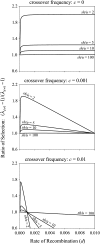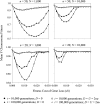Gene duplication, gene conversion and the evolution of the Y chromosome
- PMID: 20551442
- PMCID: PMC2940292
- DOI: 10.1534/genetics.110.116756
Gene duplication, gene conversion and the evolution of the Y chromosome
Abstract
Nonrecombining chromosomes, such as the Y, are expected to degenerate over time due to reduced efficacy of natural selection compared to chromosomes that recombine. However, gene duplication, coupled with gene conversion between duplicate pairs, can potentially counteract forces of evolutionary decay that accompany asexual reproduction. Using a combination of analytical and computer simulation methods, we explicitly show that, although gene conversion has little impact on the probability that duplicates become fixed within a population, conversion can be effective at maintaining the functionality of Y-linked duplicates that have already become fixed. The coupling of Y-linked gene duplication and gene conversion between paralogs can also prove costly by increasing the rate of nonhomologous crossovers between duplicate pairs. Such crossovers can generate an abnormal Y chromosome, as was recently shown to reduce male fertility in humans. The results represent a step toward explaining some of the more peculiar attributes of the human Y as well as preliminary Y-linked sequence data from other mammals and Drosophila. The results may also be applicable to the recently observed pattern of tetraploidy and gene conversion in asexual, bdelloid rotifers.
Figures





Similar articles
-
Y-chromosome evolution: emerging insights into processes of Y-chromosome degeneration.Nat Rev Genet. 2013 Feb;14(2):113-24. doi: 10.1038/nrg3366. Nat Rev Genet. 2013. PMID: 23329112 Free PMC article. Review.
-
Muller's ratchet of the Y chromosome with gene conversion.Genetics. 2022 Jan 4;220(1):iyab204. doi: 10.1093/genetics/iyab204. Genetics. 2022. PMID: 34791206 Free PMC article.
-
Can intra-Y gene conversion oppose the degeneration of the human Y chromosome? A simulation study.Genome Biol Evol. 2010 Jul 12;2:347-57. doi: 10.1093/gbe/evq026. Genome Biol Evol. 2010. PMID: 20624739 Free PMC article.
-
Molecular evolution of a Y chromosome to autosome gene duplication in Drosophila.Mol Biol Evol. 2011 Mar;28(3):1293-306. doi: 10.1093/molbev/msq334. Epub 2010 Dec 16. Mol Biol Evol. 2011. PMID: 21172827
-
Y chromosome palindromes and gene conversion.Hum Genet. 2017 May;136(5):605-619. doi: 10.1007/s00439-017-1777-8. Epub 2017 Mar 16. Hum Genet. 2017. PMID: 28303348 Review.
Cited by
-
Sex-chromosome evolution: recent progress and the influence of male and female heterogamety.Nat Rev Genet. 2011 Mar;12(3):157-66. doi: 10.1038/nrg2948. Epub 2011 Feb 8. Nat Rev Genet. 2011. PMID: 21301475 Review.
-
Ampliconic Genes on the Great Ape Y Chromosomes: Rapid Evolution of Copy Number but Conservation of Expression Levels.Genome Biol Evol. 2020 Jun 1;12(6):842-859. doi: 10.1093/gbe/evaa088. Genome Biol Evol. 2020. PMID: 32374870 Free PMC article.
-
Y-chromosome evolution: emerging insights into processes of Y-chromosome degeneration.Nat Rev Genet. 2013 Feb;14(2):113-24. doi: 10.1038/nrg3366. Nat Rev Genet. 2013. PMID: 23329112 Free PMC article. Review.
-
High Levels of Copy Number Variation of Ampliconic Genes across Major Human Y Haplogroups.Genome Biol Evol. 2018 May 1;10(5):1333-1350. doi: 10.1093/gbe/evy086. Genome Biol Evol. 2018. PMID: 29718380 Free PMC article.
-
Sex-limited chromosomes and non-reproductive traits.BMC Biol. 2022 Jul 6;20(1):156. doi: 10.1186/s12915-022-01357-5. BMC Biol. 2022. PMID: 35794589 Free PMC article. Review.
References
-
- Alföldi, J. E., 2008. Sequence of mouse Y chromosome. Ph.D. Dissertation, MIT, Cambridge, MA.
-
- Bachtrog, D., 2006. A dynamic view of sex chromosome evolution. Curr. Opin. Genet. Dev. 16 578–585. - PubMed
-
- Bengtsson, B. O., 1986. Biased conversion as the primary function of recombination. Genet. Res. 47 77–80. - PubMed
-
- Bengtsson, B. O., 1990. The effect of biased conversion on the mutation load. Genet. Res. 55 183–187. - PubMed
Publication types
MeSH terms
Grants and funding
LinkOut - more resources
Full Text Sources
Molecular Biology Databases

